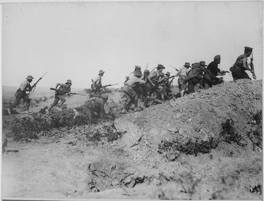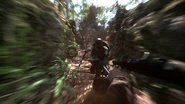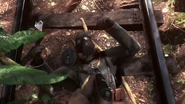No edit summary Tag: Visual edit |
|||
| Line 48: | Line 48: | ||
==Trivia== |
==Trivia== |
||
| − | *Although certain weapons have longer bayonets, the blade length |
+ | *Although certain weapons have longer bayonets, the blade length doesn't matter in competing charges. |
*Players in vehicles cannot be harmed by a bayonet charge. This includes [[horse]] riders and [[Mortar (Battlefield 1)|mortar]] users. |
*Players in vehicles cannot be harmed by a bayonet charge. This includes [[horse]] riders and [[Mortar (Battlefield 1)|mortar]] users. |
||
Revision as of 17:07, 20 January 2018

A bayonet charge in Gallipoli performed by Australian Infantry in World War I.
A Bayonet Charge is a tactic in which infantry, equipped with firearms attached with bayonets, attack an enemy position by closing to melee range at best speed and engaging the enemy in close quarters battle. The tactic was introduced along with the bayonet during the 18th century and was a common staple of Napoleonic warfare, due to the lengthy reload time and low accuracy of the firearms of the era. By World War I, the tactic had been made obsolete due to the improvements to rifles and the development of the machine gun, but was still frequently utilized, resulting in massive casualties. Capturing trenches were often the objective of bayonet charges over no-man's-land.
In subsequent wars, bayonet charges became increasingly rarer, only being used when friendly fire was a concern or as a "last resort". Affixing bayonets in readiness for an attack can be seen as a morale boost and can be used to rally forces, as well as signify to friend and foe the willingness to kill at close range.
Battlefield 1
Bayonet Charging is a feature of Battlefield 1. Almost all primary weapons in the game can be fitted with a bayonet, allowing the user to initiate a bayonet charge by pressing Melee attack while sprinting.
A gauge around the weapon crosshair shows how long the charge can be maintained—after depleting the player will return to normal speed. A second meter in the kit HUD area shows when the player may initiate a charge. Connecting with an enemy during a bayonet charge will initiate a takedown and award the player with a 'bayonet charge' kill regardless of primary weapon used. The charge can kill infantry of any class, even elites. While charging, the player does not have increased resistance to damage so this should be used with caution.
The charge is faster than sprinting and allows players to cover a short span of ground quickly and rapidly close with their target. After any charge attempt, the player must regain stamina before they can sprint or begin another charge, and can only perform melee attacks with their standard melee weapon. Consequently, a sprinting player will eventually overtake a player that has performed a charge. It is advised to only perform charges when intending to kill a player or when trying to quickly find cover.
Players initiating charges yell loudly. The yelling may be heard by players on the opposing team, which can alert them to players in their vicinity.
During the charge the player cannot fire their weapons or vault, as doing so will end the charge. A charging player cannot quickly cancel the charge, making them vulnerable to counterattack should they miss. If the player attempts to charge at too close a distance, they will instead deal moderate damage without a takedown, ending the charge. Charging reduces mobility; an opponent may dodge, giving them an opportunity to counterattack.
Should opposing players charge at each other, the last player to begin his charge will be granted the takedown and kill, should they have room to react.
Takedowns
| Direction | Target Stance | Action |
|---|---|---|
| Front | Standing/Crouching | The attacker lunges into the target's chest, knocking them down. |
| Left | Standing/Crouching | The attacker spears the target's rear ribcage, lifting them slightly with another thrust, then drops them. |
| Right | Standing/Crouching | The attacker stabs the target's throat and forces the target down. |
| Back | Standing/Crouching | The attacker drives their bayonet into the target's spine. The target drops limp to their knees, and the attacker kicks them off the weapon. |
| Any | Prone | The attacker drives their weapon downward into the target's lower back. The target is turned belly-up as the bayonet is removed. |
Gallery
Trivia
- Although certain weapons have longer bayonets, the blade length doesn't matter in competing charges.
- Players in vehicles cannot be harmed by a bayonet charge. This includes horse riders and mortar users.
- Charging players can be caught by normal melee attacks, with takedowns causing them to abruptly stop their charge.
- Dogtags can be claimed from killing enemies with a bayonet charge just like with melee takedowns.
- Before the May Update, charging players would receive a reduced damage from gunfire.
- The May Update also increased the turn radius of a charger player, making them unable to pull off tight turns.
| |||||||||||||||||||||||


